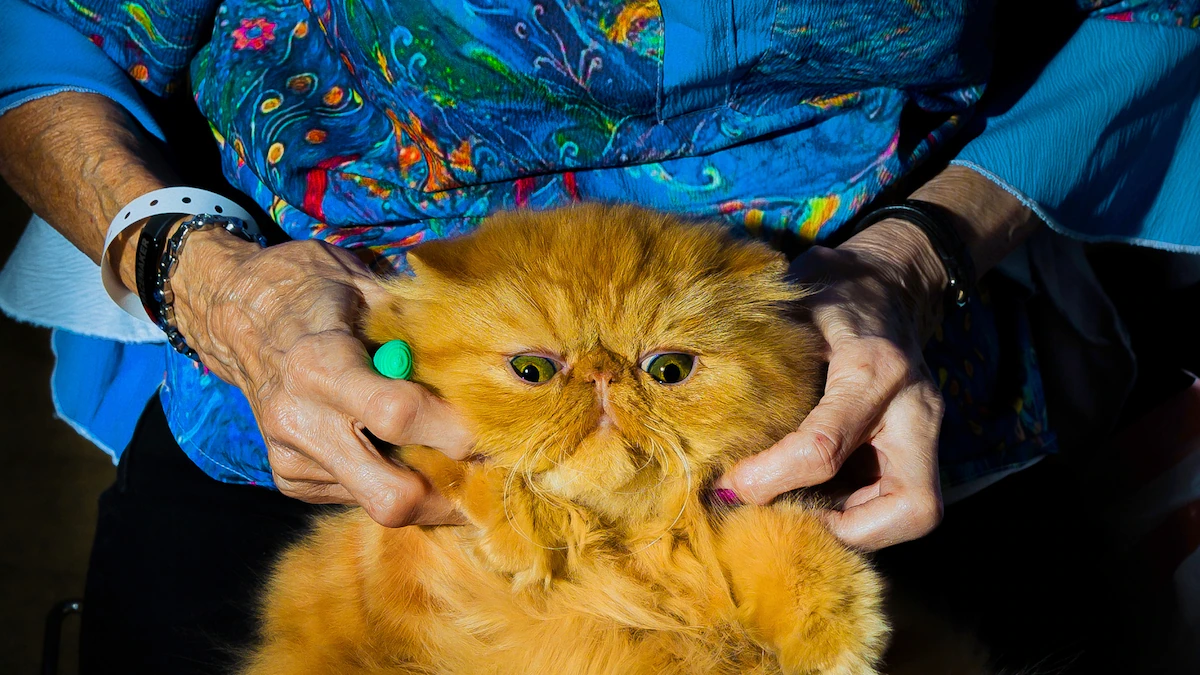Copyright National Geographic

Walking into the 2025 Cat Fancier Association International Cat Show & Expo, there is no mistaking where you are. On the main stage, performers belt out Taylor Swift’s song “22,” but they have replaced the lyrics with meows—it’s “Cat-aoke,” after all—and they are joined by a trio of dancing, cat-themed Furries. Nearby, there’s a four-foot-tall cat tower with two adult humans sitting atop cosplaying as Rum Tum Tugger and Electra from the Broadway musical Cats. They mew as I walk past. Vendors sell cat houses that look like more like condos, or even the White House. A booth demonstrates a $900 futuristic-looking box that promises to dry your freshly-bathed pet quickly and quietly. The main event—and the one people have traveled from as far away as Finland, Hong Kong, Japan, and Russia to attend—takes up the back half of Cleveland’s International Exposition Center. Here, cat owners and breeders camp out in rows upon rows of beds, carriers, strollers, and miniature shrines to their felines. Giant banners hang from the ceiling to organize the breeds of participants alphabetically, with the Siamese, Siberians, and Sphynxes here and the Maine Coon Cats and Manx over there. Just behind their ranks, a dozen “rings” offer simultaneous bouts of competition where the world’s most respected judges evaluate each animal for tiny differences that set the champions apart from the grand champions. Cheers and applause erupt after each decision. LIMITED TIME OFFER One judge, Peter Vanwonterghem, wearing a white silk suite and matching bowtie, lives in Belgium but judges shows in Asia, Europe, and the U.S. For more than two decades, he’s judged CFA shows like this one. “This show really brings the best cats from all over the world, and they can compete against each other, which they don’t normally get to do,” he says. In search of a “once-in-a-lifetime” cat While dog shows have garnered more of the limelight thanks to television contracts (not to mention Christopher Guest and Eugene Levy’s epic satire, Best In Show), the CFA has been quietly doing its own thing since 1906. “It started as a group of cat lovers that wanted to hang out together,” says Desiree Bobby, CFA marketing director and brand manager, as well as a producer of the CFA Cat Expo. “And what else do you really do when you have something you love? They started competing against each other as to who had the loveliest cat.” Today, the CFA allows owners to compete across 45 different cat breeds and in three general categories. The kitten category is for cats between four and eight months of age, and the adult class is split into two more groups—one for cats that are still able to breed and one for those that are spayed or neutered, known as premiership. While the Cleveland show is the biggest must-attend event for cat enthusiasts, it’s not the final round for competitors. From Malaysia to Tennessee, the CFA sanctions about 250 shows each year. Each time a cat enters a ring, it can score points that accumulate over the course of the year. In May, the organization reveals the world’s top-ranked cats based on total point tallies. Unlike the dog competitions you might be familiar with, cats do not need to demonstrate their ability to follow commands or navigate obstacles. Rather, each cat is placed on a pedestal between two scratching poles and evaluated against a written standard. Categories include everything from its head shape and size to the ears, eyes, and tail. Color, markings, temperament, and behavior all factor in. Breeding champions There can also be a surprising amount of science here. Breeders select for specific traits over generations, carefully combining genetics of lineages that result in kittens ever closer to what they view as perfection. “The Selkirk rex coat is a beautiful example of Mendelian genetics,” says Ashley Dzubak, a breeder and veterinarian from Columbus, Ohio. “It is an autosomal, dominant gene.” For example, Dzubak’s Selkirk rex, Sienna, looks like she has a slight perm—the result of possessing one of two possible genes for the breed’s signature curls. Because the gene is autosomal, it can be passed down to either males or females, and it is also dominant, so only one gene is necessary to produce the curly coat. But a cat with both copies of the gene would be “super curly,” Dzubak explains. As a way to enlarge their gene pool, some breeders develop longstanding relationships with others in the cat show world. Redding is based in southern California, for instance, but trades cats with a close friend in Wisconsin. “Each of us working together doubles the size of our cattery,” says Redding. Owners and breeders have all sorts of tricks to prepare their cats for competition, too. Shayla Copas from Little Rock, Arkansas has an exercise wheel at home that her Bengal, named Rocco, runs on to stay muscular. Stephanie Newberry of Indianapolis, Indiana credits playing with her six kids as the reason why Syrup, a ragamuffin, is able to handle all the noise and commotion of cat show life. And Douglas Martin, from San Diego, says that growing up with Himalayan cats taught him how to properly care for animals with long, luxurious hair. From pets to pedigrees While many of the show’s attendees have cats that hail from select bloodlines, owners of more common cats also can showcase their furbabies in a housecat category. This provides an easy entry point for those new to the cat show scene, as well as an avenue for those with show cats who have some sort of disqualifying fault that bars them from the general competition — a tail that’s too long or short to meet the written standard, for instance. “Look at that mustache!” judge Teresa Sweeney exclaims to the assembled crowd, pointing out a black-and-white cat’s facial coloration before adding a ribbon to her cage. The crowd claps politely, and Sweeney, whose blouse shimmers in three colors of sequins, moves down the line in her rankings. “This is probably the biggest turnout we’ve had all year for the Household Pets category,” says Sweeney, once she’s finished posing for pictures with several of the winners and their owners. “The CFA welcomes all cats, and that’s why this category is important.” Unlike with breeds, there's no standard criteria for ranking household cats, but judges look for "that extra charisma, that shine, the grooming, the presentation," Sweeney says. Smudge the Mustache Cat, as she’s known on Facebook, has been in Meow Mix commercials and will soon appear in a movie directed by Maggie Gyllenhaal, but isn’t able to compete in the pedigree classes because her provenance is unknown. “Her mother showed up pregnant on my porch,” says Dawn Strosko of Hunker, Pennsylvania, who has been showing cats for about 25 years. Required: A love cats Barbara Bleifuss of South Jersey started out showing her household cat. Now, she shows Persians. Seeing her pet cat give birth when she was 9 years old changed her life and eventually set her on a path to become a NICU nurse for nearly three decades. “I thought it was pretty magical,” she says as she tries to hang on to Carmen, her flat-faced tabby. Bleifuss might have even gone on to become a veterinarian, she says, but “back in the ‘60s, they wouldn’t accept women in veterinary school.” While many attendees cite the human camaraderie as a main draw, others do it sheerly for their love of cats. Dzubak, the veterinarian, will go to anywhere from five to 50 shows each year, even though there’s no prize money involved. “A lot of it is just honestly spending time with your cat. I’ve found some really amazing bonds with the cats that I show,” she says. “The Expo was created not just as a cat show, but as a bridge—a place where preservation breeders, rescue advocates, and everyday cat lovers can come together under one roof,” says Bobby of the CFA. After hours of watching cats bat at ribbons and bask in the glow of their owners and onlookers alike, the competition comes to a close. A 14-month-old male Bombay named Burmania Pepin of Elessar, whose owners are C. Williams, Vivian Baylor, and Isabelle Marchand, took the Best in Show title among the pedigreed entrants. A black-and-white spay named Loki, owned by Cindy Rich, was the Best Cat in the Household Pet category. Taking a last look around the arena with the lyrics of American comedy disco duo Koo Koo lodged firmly in my brain—“We are gonna have a cat party. We’re gonna have a cat parrrrrty. We are gonna have a cat party, so bring your cat, and something to share!”—I can’t help but feel like everyone here looks as if they’ve won something. “I think,” says Bleiffus, while staring into the amber eyes of her squish-faced Carmen, “that anybody that goes home to an empty house and isn’t met at the door with a fuzzy cat or dog is really missing a lot.”



